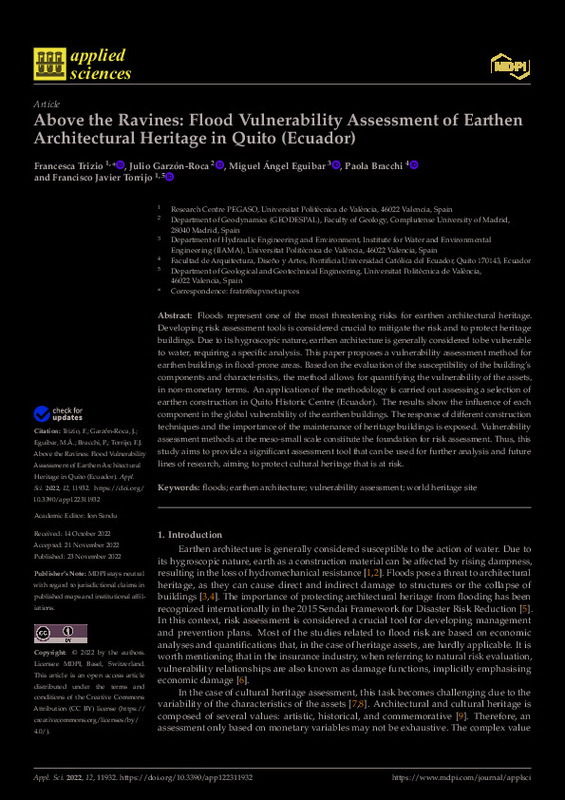JavaScript is disabled for your browser. Some features of this site may not work without it.
Buscar en RiuNet
Listar
Mi cuenta
Estadísticas
Ayuda RiuNet
Admin. UPV
Above the Ravines: Flood Vulnerability Assessment of Earthen Architectural Heritage in Quito (Ecuador)
Mostrar el registro sencillo del ítem
Ficheros en el ítem
| dc.contributor.author | Trizio, Francesca
|
es_ES |
| dc.contributor.author | Garzón-Roca, Julio
|
es_ES |
| dc.contributor.author | Eguibar Galán, Miguel Ángel
|
es_ES |
| dc.contributor.author | Bracchi, Paola
|
es_ES |
| dc.contributor.author | Torrijo, F.J.
|
es_ES |
| dc.date.accessioned | 2023-05-26T18:01:48Z | |
| dc.date.available | 2023-05-26T18:01:48Z | |
| dc.date.issued | 2022-12 | es_ES |
| dc.identifier.uri | http://hdl.handle.net/10251/193632 | |
| dc.description.abstract | [EN] Floods represent one of the most threatening risks for earthen architectural heritage. Developing risk assessment tools is considered crucial to mitigate the risk and to protect heritage buildings. Due to its hygroscopic nature, earthen architecture is generally considered to be vulnerable to water, requiring a specific analysis. This paper proposes a vulnerability assessment method for earthen buildings in flood-prone areas. Based on the evaluation of the susceptibility of the building's components and characteristics, the method allows for quantifying the vulnerability of the assets, in non-monetary terms. An application of the methodology is carried out assessing a selection of earthen construction in Quito Historic Centre (Ecuador). The results show the influence of each component in the global vulnerability of the earthen buildings. The response of different construction techniques and the importance of the maintenance of heritage buildings is exposed. Vulnerability assessment methods at the meso-small scale constitute the foundation for risk assessment. Thus, this study aims to provide a significant assessment tool that can be used for further analysis and future lines of research, aiming to protect cultural heritage that is at risk. | es_ES |
| dc.description.sponsorship | This research was made possible thanks to the fund given to the first author by Universitat Politecnica de Valencia, by means of a "Grant for the mobility of PhD students", grant number 006070000-541-47110. | es_ES |
| dc.language | Inglés | es_ES |
| dc.publisher | MDPI AG | es_ES |
| dc.relation.ispartof | Applied Sciences | es_ES |
| dc.rights | Reconocimiento (by) | es_ES |
| dc.subject | Floods | es_ES |
| dc.subject | Earthen architecture | es_ES |
| dc.subject | Vulnerability assessment | es_ES |
| dc.subject | World heritage site | es_ES |
| dc.subject.classification | INGENIERIA HIDRAULICA | es_ES |
| dc.subject.classification | INGENIERIA DEL TERRENO | es_ES |
| dc.title | Above the Ravines: Flood Vulnerability Assessment of Earthen Architectural Heritage in Quito (Ecuador) | es_ES |
| dc.type | Artículo | es_ES |
| dc.identifier.doi | 10.3390/app122311932 | es_ES |
| dc.relation.projectID | info:eu-repo/grantAgreement/UPV//006070000-541-47110/ | es_ES |
| dc.rights.accessRights | Abierto | es_ES |
| dc.contributor.affiliation | Universitat Politècnica de València. Escuela Técnica Superior de Ingenieros de Caminos, Canales y Puertos - Escola Tècnica Superior d'Enginyers de Camins, Canals i Ports | es_ES |
| dc.description.bibliographicCitation | Trizio, F.; Garzón-Roca, J.; Eguibar Galán, MÁ.; Bracchi, P.; Torrijo, F. (2022). Above the Ravines: Flood Vulnerability Assessment of Earthen Architectural Heritage in Quito (Ecuador). Applied Sciences. 12(23):1-17. https://doi.org/10.3390/app122311932 | es_ES |
| dc.description.accrualMethod | S | es_ES |
| dc.relation.publisherversion | https://doi.org/10.3390/app122311932 | es_ES |
| dc.description.upvformatpinicio | 1 | es_ES |
| dc.description.upvformatpfin | 17 | es_ES |
| dc.type.version | info:eu-repo/semantics/publishedVersion | es_ES |
| dc.description.volume | 12 | es_ES |
| dc.description.issue | 23 | es_ES |
| dc.identifier.eissn | 2076-3417 | es_ES |
| dc.relation.pasarela | S\478005 | es_ES |
| dc.contributor.funder | Universitat Politècnica de València | es_ES |








